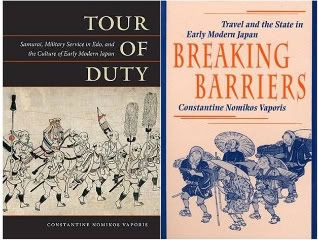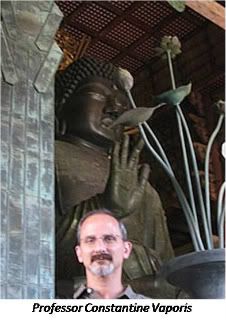
For anyone who has been reading the Samurai Archives forums for the past six months has likely seen or heard of Dr. Thomas Conlan. In recent years, this credited academic has brought his not inconsiderable talents to bear in the area of samurai and military history, a subject that is too often dismissed in serious academic circles.
My first introduction to Dr. Conlan's work came in the form of his monograph on the Mongol invasions, In Little Need of Divine Intervention, and taking his studies into the 14th century is a logical extension of that research. It is an area that is all too often overlooked, with most popular books focusing on either the Gempei Wars of the late 12th century or the exciting turbulence of the Sengoku period and the late 16th century; however, this leaves a large field between the two relatively untouched, except in the more scholarly journals.
Dr. Conlan's greatest asset is his ability to bring serious academic research and make it accessible to the armchair enthusiast. The well-organized and clear narrative is accompanied by stats and charts for those interested in a more detailed analysis. Furthermore, Dr. Conlan approaches the subject with a refreshing pragmatism, eschewing the popular mythology and legend that tends to cloud many popular works on the subject of pre-modern Japanese warriors.
The books starts off with a contemporary account of one of the warriors of the early 14th century, Nomoto Tomoyuki. Through records of the deeds performed by this warrior, written up as a petition for rewards by his son and preserved in the family records of the Kumagai down to the present day. This chapter uses Tomoyuki's escapades as a focus for a look at what it was like for warriors on the campaign. He draws particular attention to the bureaucracy involved; the need to have evidence in order to gain rewards for service in battle led the now well-documented instances of warriors who might show up for a battle and leave after taking only a single head, or even right after they were recorded as being in the camp!
This narrative, given at the ground level, as it were, is supplemented in the second chapter by a statistical analysis of 14th century warfare that provides a framework for describing the techniques and tactics employed by the armies of the time. Documentary evidence of wounds, usually recorded in the petitions, are drawn out in excruciating detail. In one appendix to the chapter (which is placed immediately following the chapter, vice at the end of the book), he provides numbers for all the documented deaths and wounds from 1333 to 1394, as well as listing the number of documents known to have been submitted in each year.
Other chapters detail the backbone of war, and how it was waged: supply lines, social and financial ramifications, religious influences, and legitimation. The make-up of the military, as well as how loyalties functioned within the first century of the Ashikaga shogunate, were quite interesting. He discusses the positions of retainers (wakatō) and the bakufu's housemen (gokennin), and their contributions to 14th century warfare. There is a lot of ground covered here, and I was really quite pleased with all of it.
However, buried within my praise, I must also acknowledge several things that let me down, especially in an otherwise enthralling work. First off, Dr. Conlan should have a word with his editor. There were many misspellings and grammatical mistakes that should never have made it to print (e.g. Nanbukucho v. Nanbokucho), especially in a book released by an academic institution focusing on Japanese studies. These are the sorts of things that are easy to miss when writing a book covering so much ground, but should also have been easy for a proofreader to pick up and mark for editing.
There were also some stylistic choices I can't say I agree with. References to figures are written as double references (e.g. "See figures 9 = pl. 7 and 10"), which were rather cryptic; the color plates didn't show up until near the end of the book, but before the final conclusion, their placement not making much sense. Dr. Conlan also appears to be overly enamored of the square bracket, leading to such sentences in his translation as: "[Nobutsune?] cut down one horseman wearing dyed and patterned [kōketsu] armor [hitatare]." This leads to confusion over whether a parenthetical is an assumed oversight in the original or if it is an explanation; e.g. if one does not already have a grasp of Japanese armor and clothing, one might assume that "hitatare" refers to a type of armor, rather than the original refering to a yoroi hitatare.
For someone who is interested in the precise terms, however, this flaw can often be a virtue. Many words that most modern authors would eschew from translating, or else provide only in the original Japanese, are given both in English and with a translation. Though at times tedious, unnecessarily breaking up the flow of the text, there are other times when it will be found a boon by the highly detail oriented amongst us.
It should be noted, that despite my objections, the style and grammar have little to do with the actual content, which is tremendous. The account, in the first chapter, of Nomoto Tomoyuki's service is an excellent exemplar of the type of service rendered by the average warrior during the 14th century. The statistics, gathered mostly in chapter two, contribute to the overall picture of violence in the 14th century. Further chapters elluminate such subjects as the role of violence in the social order. Dr. Conlan provides his audience with a compendium of modern scholarship on the issue. All of this helps to make this an eminently worthwhile book, and one that should be on the shelf of anyone seriously studying the history of warfare in Japan.
And for those looking for more, Dr. Conlan told SA during his interview that he was planning to expand the chapter on religion and war into his next monograph--so keep your eyes peeled.
For this, and other must-read books on Japanese history, check out the Samurai Archives Bookstore, hosted by Amazon.


